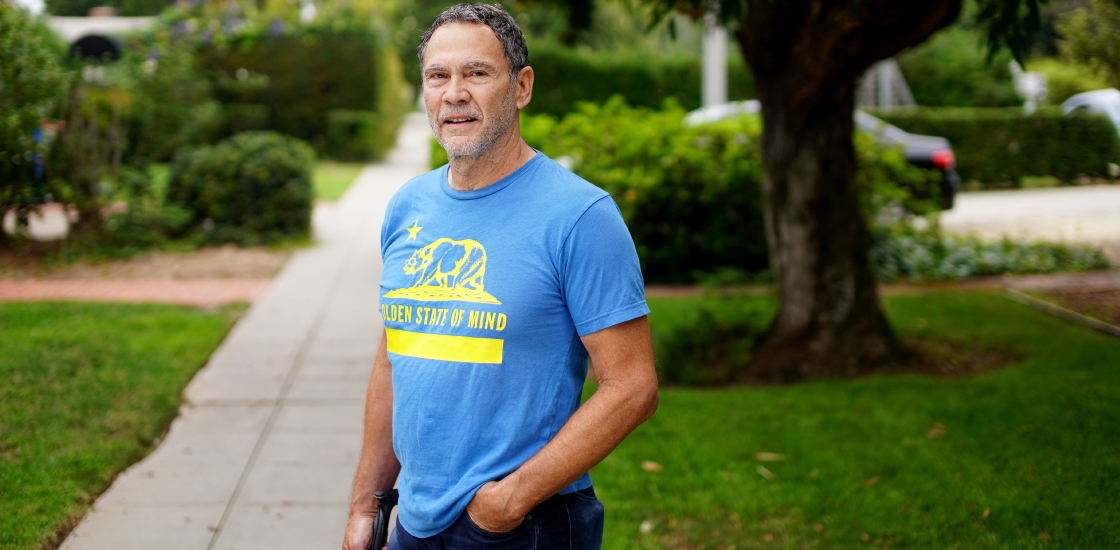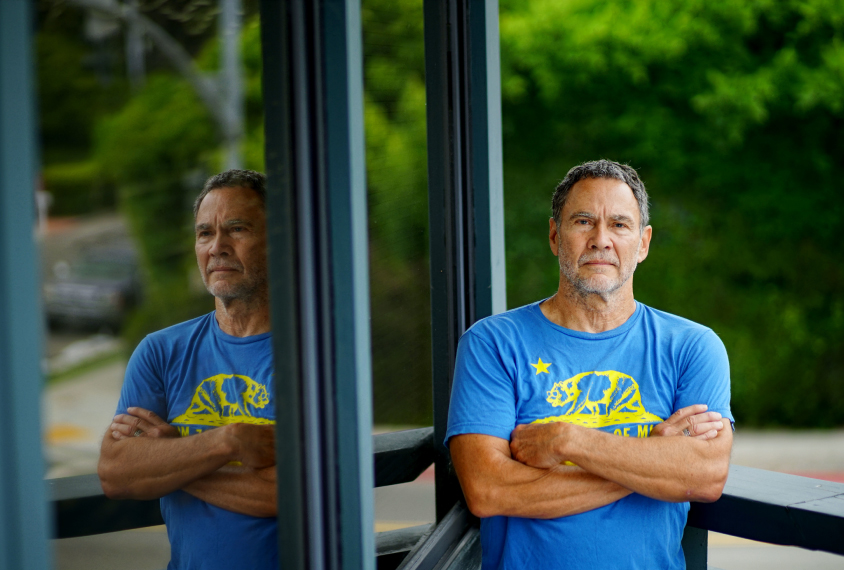Eric Courchesne: Reaching for the rings in autism research
Eric Courchesne is known for his findings on brain size in autism. But the roots of his long career trace back to his own childhood disability.

Eric Courchesne’s career in autism research began with an elevator pitch.
It was around 1980, and Courchesne had just started his first faculty job in the neuroscience department at the University of California, San Diego. In the elevator at Rady Children’s Hospital one day, he met a clinical psychologist. They exchanged what-do-you-do pleasantries, and Courchesne explained that he was studying the brain’s electrical responses to novelty — sights and sounds that a person has not experienced before.
“She said, ‘Well you should study autism, because autistic children don’t seem to be interested in novelty; they seem to be interested in repeating the same stimuli again and again,’” recalls Courchesne, who is now professor of neuroscience at the university and co-director of its Autism Center of Excellence.
The psychologist introduced Courchesne to a 15-year-old boy with autism, and Courchesne recorded the boy’s brain waves. He discovered that the boy, along with nine other adolescents and young adults with autism, indeed turned out not to show the typical brain response to new things1.
“That was it,” Courchesne says. “I said, ‘Oh finally, this is the developmental disorder that I’m going to study.’”
At the time, few neuroscientists were studying autism; some scientists had never even heard of the condition. But Courchesne had a long-standing interest in the development of the nervous system: He had contracted polio at age 4, which paralyzed the muscles in his legs. It took six surgeries over five years for him to stand and walk on his own again.
Courchesne doesn’t shy away from talking about his disability; on the contrary, it’s one of the first things he mentions when he meets someone new. And his repeated references to polio suggest that the illness has influenced not only his interest in autism, but his entire scientific career.
Today, Courchesne walks with a splayed-out, twisting gait but has the powerful upper body of a former gymnast. He has also made huge strides in understanding autism. He is best known for his findings on brain size. In 2001, his team reported that the brains of children with autism are larger than those of their typical peers in the first few years of life, but smaller later on2. He led a large imaging study that confirmed the findings in 20103.
This pattern of brain growth affects only a subset of people with autism, but it is one of the most consistently replicated anatomical findings related to the condition. It helped to solidify the idea of autism as a biological condition with roots in the brain, rather than one that is purely psychological.
His discoveries extend beyond brain growth. Courchesne “has an encyclopedic knowledge of neuroscience,” says Lisa Eyler, professor of psychiatry at the University of California, San Diego, who collaborates with Courchesne on imaging studies. Over the years, Courchesne has brought that knowledge to bear on topics as disparate as the function of the cerebellum and how the brains of preverbal children respond to language.
Competitive advantage:
Courchesne was born and raised in Berkeley, California, in a family with a love of learning that slanted toward the humanities. His father had a rich trove of poems committed to memory. His mother spoke a half-dozen languages and played piano and violin, performing around the Bay Area.
His first taste of scientific research came when he was an undergraduate at the University of California, Berkeley in the late 1960s. He and a friend studied hermit crabs in local tide pools with the aim of understanding aggression in animals4. (It was the Vietnam War era, after all, and Berkeley was a hotbed of antiwar protests.)
Courchesne started taking classes at the university in his final year of high school, at age 16. One day after class, the gymnastics coach noticed him hanging around the gym and invited him to try out for the team. It was a powerful experience of inclusion. “The coach wasn’t bothered by the disabilities part. He said, ‘Well, come on in,’” Courchesne says.
Courchesne competed on the pommel horse, and one year won the Pac-10 Conference on still rings. Years later, he realized that the uneven strength in his arms, a legacy of the polio infection, had forced him to start his routine on rings with a move that is considered unusually difficult, so he often garnered high scores. Without being conscious of it, he had not only adapted to his disability, but turned it into a competitive advantage.
Others see a similar adaptability, and a willingness to take on difficult challenges, in his scientific career.
“He isn’t stuck in a particular method, approach, or even question,” says Elizabeth Redcay, assistant professor of psychology at the University of Maryland, who was a graduate student in Courchesne’s lab from 2002 to 2008. “His goal is to understand autism, and often that means seeking well beyond his current work and comfort zone.”
Growing evidence:
In casual conversation, Courchesne has an easygoing manner that suits his shaggy hair, salt-and-pepper stubble and wardrobe staple — graphic T-shirts. His lab, which he shares with his wife Karen Pierce, who is also an autism researcher, is on a street with a sleepy, beach-town feel, just blocks from the Pacific Ocean in La Jolla. Lab members are known to take breaks from their experiments to ride the waves. “My surfboard lived in the office for a while,” Redcay says.
But the lab’s trappings belie its leader’s combative streak: Courchesne can be sensitive to criticism, quick to dismiss questioning from colleagues and competitors — and slow to let it go. Asked about a time when he’s been wrong scientifically, he only mentions ideas that didn’t gain traction at first, such as the role of the cerebellum in autism, but have since been vindicated.

In the past 15 years, Courchesne has been trying to trace the origins of the abnormal brain growth in autism, and the mechanisms that govern it. For this work, he needed brain tissue from children with autism.
Postmortem brain tissue is scarce, and that from young children even more so. It took five years for Courchesne to gather samples. In 2011, his team reported that seven boys with autism had an excess of neurons in their prefrontal cortex, a brain region involved in complex thought and planning5. All of the nerve cells in this region appear before birth, so the results point to a prenatal origin for altered brain growth in autism, Courchesne says.
Three years later, Corchesne’s team analyzed brain tissue from 11 children with autism and 11 controls and found patches of immature cells, and disruptions of the characteristic layered structure of the brain’s outer region, the cerebral cortex, in the children with autism6. This finding suggests that autism brains have excess neurons because too many of them form, not because too few are pared back in a process called pruning, Courchesne says.
Other researchers in the field were skeptical of these studies because of the small number of brains and the focus on a few areas of the cortex. But the critique doesn’t faze Courchesne, who says other advances in autism research are also based on small sample sizes.
Courchesne has since reported more evidence to support his theory. For example, neurons made from skin cells of toddlers with autism who had enlarged heads divide faster than those of typical toddlers7. The larger the child’s brain, the more rapidly the neurons proliferate.
Other researchers praise the diverse set of approaches Courchesne has used to explore these questions. Konstantinos Zarbalis has not met or worked with Courchesne but says his work helped him interpret his own results. Zarbalis’ research on mutant mice showed many of the same brain anomalies — increased head size, excess neurons, patches of abnormal cortex — that Courchesne identified in people with autism. Courchesne’s findings “tied everything together,” says Zarbalis, associate professor of pathology at the University of California, Davis.
Engaging parents:
Courchesne and Pierce met when she was a postdoctoral fellow in another lab at the university. They have a 14-year-old daughter and a 12-year-old son, and work closely together. Pierce sat in during the interview of Courchesne for this article; the two sometimes finish each other’s sentences and talk in a clipped, almost coded way when, for example, discussing the maximum strength of a magnetic resonance imaging magnet or calculating exactly how long they have been a couple.
Pierce studies eye tracking as an indicator of autism risk and has pioneered an approach to identify children at high risk for autism as early as 12 months of age. Together, she and Courchesne study how the brains of children at risk for autism respond to language.
“It’s great that [he is] this massively awesome basic science researcher and me a little more clinically minded,” Pierce says. “We can kind of feed off of each other and push the research forward together.”
The couple’s imaging studies have involved many late nights because they scan children while the children are sleeping. Courchesne doesn’t shy away from the long hours.
“Usually you have a senior scientist and they develop the study, and then when the data collection comes around they’re pretty hands-off,” Eyler says. “That’s not how Eric works, that’s never been how he works; he always wants to meet the families and interact with the participants.”
Courchesne says he can’t imagine doing otherwise. His own experience with polio left him with particular empathy for what parents of children with autism might experience. “Some parents feel the way my parents felt,” he says. “I became a champion gymnast, a successful scientist. And to the end of my parents’ lives, they still cried every time they thought of the beginning; it was a trauma that they never stopped feeling.”
He lists things that may seem out of reach for some children with autism, especially those with significant disabilities: being on a soccer team, running over to a friend’s house to watch a movie, joining a game on the playground. In some ways, the goal of his research is to help them experience some of the very things he missed out on.
References:
- Courchesne E. et al. J. Autism Dev. Disord. 15, 55-76 (1985) PubMed
- Courchesne E. et al. Neurology 57, 245-254 (2001) PubMed
- Courchesne E. et al. Brain Res. 1380, 138-145 (2011) PubMed
- Courchesne E. and G.W. Barlow J. Comp. Physiol. 75, 32-48 (1971) Abstract
- Courchesne E. et al. JAMA 306, 2001-2010 (2011) PubMed
- Stoner R. et al. N. Engl. J. Med. 370, 1209-1219 (2014) PubMed
- Marchetto M.C. et al. Mol. Psychiatry 22, 820-835 (2017) PubMed
Recommended reading
Explore more from The Transmitter

Neuro’s ark: How goats can model neurodegeneration



